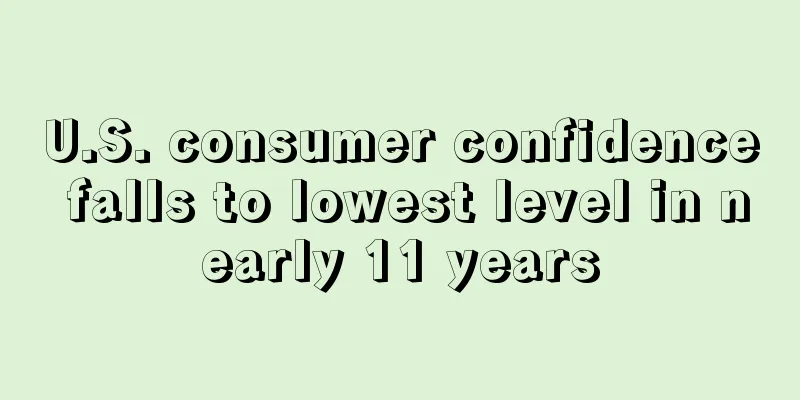U.S. consumer confidence falls to lowest level in nearly 11 years

|
U.S. consumer confidence fell to its lowest level in nearly 11 years in May as concerns about inflation persist .
According to the University of Michigan Consumer Confidence Index (MCSI) data released last Friday ( May 13), in early May 2022, the US consumer confidence index fell again, down 9.4% to 59.1%, the lowest level since 2011. However, a strong labor market and a large amount of savings still provide support for household spending, which should help US economic growth.
Some economists said that the recent deterioration in U.S. market sentiment, rising gasoline prices and stock market turmoil have affected consumer confidence indexes.
Gasoline prices resumed their upward trend this month, hitting a record high of $4.432 a gallon on Friday, according to AAA . The Federal Reserve has had to tighten monetary policy sharply to reduce the impact of inflation, sparking a massive sell-off on Wall Street.
"Consumer confidence has been a poor guide to consumption growth in recent years, so we would not read too much into this signal," said Michael Pierce, an economist at the University of California, Berkeley. "Just because consumers don't like to buy higher-priced goods and supplies are limited doesn't mean they won't make those purchases."
Economists are not concerned about this situation, noting that consumers have accumulated at least $2 trillion in excess savings during the COVID-19 pandemic .
Some people worry that high inflation and the Federal Reserve's interest rate hikes that began in March could slow economic growth or even push the economy into recession. However, under the pressure of a record trade deficit, although the US economy contracted in the first quarter, domestic demand in the United States remained strong.
While inflationary pressures in the United States are likely to persist, there are growing signs that price pressures have peaked.
A separate report from the Labor Department showed prices for imported goods were unexpectedly flat in April after rising 2.9% in March as a drop in the cost of petroleum offset increases in the prices of food and other products.
Economists had forecast that prices of imported products excluding tariffs would climb 0.6%. From April 2021 to April 2022, prices of imported products rose 12.0%.
With oil prices higher in May, monthly imports, consumer and producer prices are likely to pick up. Annual inflation is expected to continue to edge lower but is likely to remain above the Fed’s 2% target.
Therefore, sellers in the US market do not need to worry too much, as domestic consumer power remains strong, and the decline in unemployment and wage growth will also boost consumer spending. US Consumer Confidence Index inflation |
>>: Bezos slams Biden administration's tax hikes to curb inflation
Recommend
Sales and profits doubled! Kakao Commerce sales exceeded 500 billion won
Kakao Commerce announced in its audit report on A...
What is Haiyinhui? Haiyinhui Review, Features
Shantou Haiyinhui is Shenzhen Haiyinhui, which is...
What is Manual Targeting? Manual Targeting Review, Features
Manual Targeting is Amazon’s manual advertising. ...
Pretending to resign? Tokyo Olympic Organizing Committee President apologizes for "degrading women" remarks
As the date approaches, the Tokyo Olympics in Jap...
Staples is using a new e-commerce platform to promote its products
With a multi-channel online sales strategy, Stapl...
As Chinese sellers leave Amazon, has Walmart become a popular target?
During the epidemic, cross-border e-commerce has ...
American Eagle shares fall as e-commerce sales slow
According to foreign media reports, according to ...
What is Million Payment? Million Payment Review, Features
Baiwan Payment is a global electronic payment sol...
With nearly 500 e-commerce websites, can Qatar become the next blue ocean?
Public data from Qatar's Ministry of Transpor...
What is レシートがお金にか? レシートがお金にかReview, Features
Leshitoga Okinaka is an application that can be u...
More than 200,000 orders sold in two months, another big selling circle!
There are more sellers emerging in the segmented ...
What is Malacca ERP? Malacca ERP Review, Features
Shenzhen Malacca Service Business Co., Ltd. is the...
Amazon was ordered to conduct a strict investigation, and domestic sellers were sued by their peers and had a hard time
US Congress orders targeting Amazon and other onl...
12000+VAT incident, another "hidden danger" in the cross-border circle
Another "hidden danger" in the cross-bo...
What is NexTag? NexTag Review, Features
NexTag is an independent price comparison service...









